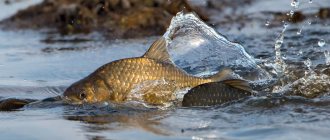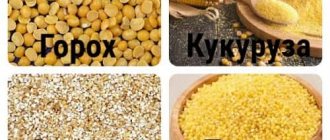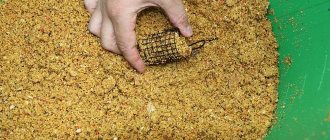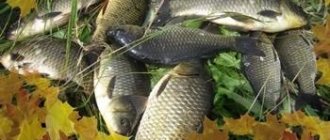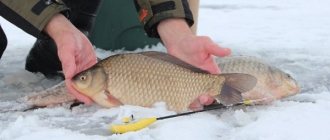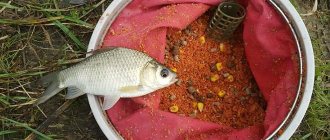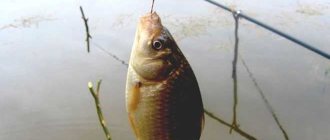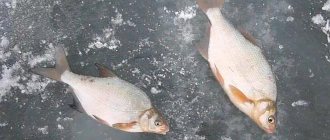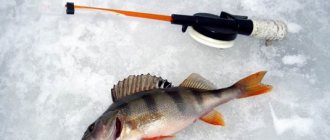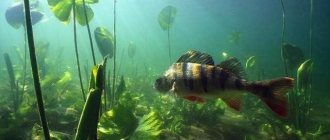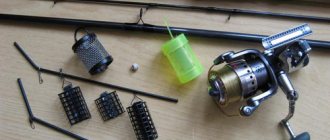Catching a trophy crucian carp in winter is a rare success. What a trophy! It’s just that you don’t come across a good specimen on every fishing trip. I know quite a few fishing enthusiasts who have never caught crucian carp in winter.
Although crucian carp is found in almost all bodies of water, it is not active everywhere in winter. The river and lake are not the best testing grounds for honing your skills in catching this fish. The chances of catching it on the lakes are almost zero. Apparently, this is due to the depletion of oxygen in the water. In rivers with strong currents, hunting for crucian carp also looks like a dubious idea. In small rivers, whirlpools or on straightenings there is some chance, but it is small.
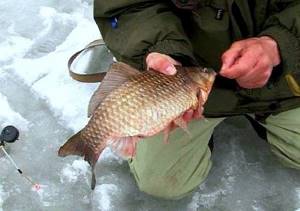
But in ponds or rivers blocked by dams, you can and should catch crucian carp. However, not every pond, even if it is filled with crucian carp and there is no end to this fish in the summer, is guaranteed to bite silver, and even more so golden crucian carp in winter. I think that science does not know for certain the reasons why in some ponds, even with clean water and not overgrown with algae, crucian carp fall asleep until spring, while in others they bite all year round. There is an opinion that it is caught where there is a predator that does not allow it to take a nap.
But, I assure you, I have more than once caught crucian carp in the “swamps”, where there was not even a smell of perch, pike, or rotan. But I can testify that if there are “toothy ones” in the reservoir, the size of crucian carp increases from year to year. Just last winter, on a pond with the romantic name Pogany, overflowing with pike, crucian carp from 600 g to 2.5 kg were actively caught on the last ice.
Ponds are rarely very deep, so crucian carp are caught at depths from 1 to 6 m. I would advise finding a small drop and positioning the holes so that the bait is at different levels. If the fishing rod works better at a shallower depth, it is possible to maneuver and drill a hole “in the shallows,” and vice versa.
Winter feeding tactics for crucian carp
Beginners sometimes make the mistake of dumping the first mixture they come across into the hole. Before using winter bait for crucian carp, consider the following points:
- The period of freeze-up, the level of fish activity;
- Type of reservoir - closed pond, reservoir or river;
- Presence of small fish in the fishing area (roach, bream, bleak, perch, ruff);
- The tastes of crucian carp on this particular body of water, which can vary greatly.
It is useless to feed in heavily silted ponds - crucian carp sleep in such places in winter. In reservoirs with a hard bottom and normal oxygen conditions, the silverfish is active all winter, and bait often helps to collect fish under the hole. The tastes of crucian carp are unpredictable, so there is no single working option. In each specific reservoir, the method of feeding is selected experimentally . An article about winter fishing for crucian carp.
The general rule is that the feeding intensity of crucian carp in winter is much weaker than in the warm season. The fish quickly becomes saturated, since the metabolism in the body is slowed down due to the low ambient temperature. Accordingly, you can use bait for crucian carp in winter only in doses , carefully, in order to attract and interest, and not feed.
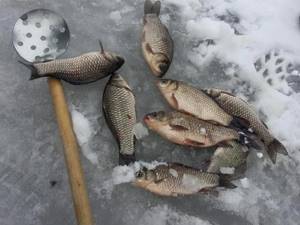
Strong odors are not suitable - they will not spread well in cold water, and a fish that suddenly finds itself in the zone of action of a strong unnatural aroma (compared to the surrounding background) will simply get scared and leave. The smell of winter bait should be weak but persistent (do not wash out quickly). The wait for fish to come to bait is longer in winter than in summer. In warm water the fish reacts within a few minutes, but in winter you have to wait 0.5-1.5 hours.
Often on closed ponds, vegetable bait does not attract crucian carp, but repels it. In such a situation, you can feed with pinches of live bloodworms, throwing several larvae into the hole from time to time.
Methods for introducing bait (depending on the conditions of the reservoir and the reaction of crucian carp to it):
- Balls into the hole;
- Dump trucks to the bottom;
- Pouring winter bait onto the crucian carp directly into the hole;
- Pouring liquid suspension;
- Using a separate feeder on the bottom during the current.
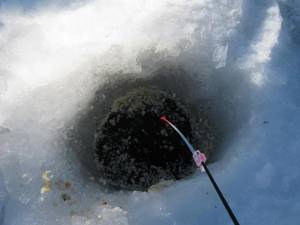
- Several promising places are being fed at once. Then the fed holes are checked to find a working one. Further, while fishing, you need to periodically add bait little by little to keep the fish under the hole.
- The method of feeding and the composition of the mixture, as already mentioned, is selected experimentally.
- If you are visiting a pond for the first time, and a reliably working option is unknown, then you need to start with simple recipes, without frills or special flavors (millet, corn grits, breadcrumbs, bloodworms, fried ground seeds, store-bought winter bait).
- Special tastes of crucian carp appear more often in closed reservoirs and ponds. In the open spaces of reservoirs, standard millet with seeds or Salapin porridge with the addition of bloodworms almost always work well.
- The only feeding that always works is live bloodworms or amphipods, since they are natural winter food everywhere and for any fish. But in some reservoirs their use is impossible due to the terror of small perch, ruff and other small things. And sometimes it’s not easy to get such a bait. Therefore, anglers more often use plant-based baits (adding live larvae to the mixture is still desirable).
- Sometimes feeding crucian carp in winter only causes harm. On some reservoirs, crucian carp leave the holes if you put something there. This happens more often on closed ponds in the dead of winter. If the crucian carp is feeding and it is known that bait cannot be sprinkled here, we catch it with small black jigs using the search method. The main thing is to find a fish site.
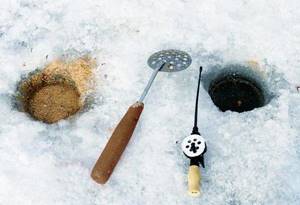
Ingredients
Everything here is not very simple, since all reservoirs are different, you will have to divide the components among different reservoirs, that is:
- Reservoirs where only crucian carp are found (usually small quarry-type lakes)
- Reservoirs with other types of fish (including rivers)
- There is another type of reservoir where it is better not to catch crucian carp in winter ; these are ponds where there is a lot of silt. Such places can be identified by the abundant vegetation along the banks (trees, tall grasses, bushes.) Such ponds work well on the last ice.
Be careful, well-heated components do not need flavorings; you can use different flavors only if other fishermen use them!
Now let’s start figuring out which body of water to cook what on.
Karas reservoirs
Here bait is not so important as attracting the attention of the fish. Therefore we take:
- Breadcrumbs (white) - 1 part
- Ground pearl barley – 1 part
- Salt – 1 teaspoon (if there is severe frost from 15 degrees)
- Ground hemp seed - 1 part
- Flour – 1 part
- Groundbait bloodworm (the more the better)
Rusks, pearl barley and hemp need to be ground and heated in a frying pan separately.
Mix the first 5 components and moisten with distilled water (you can take store-bought drinking water and boil it) immediately before going fishing . At the pond we crush the bloodworms into a “porridge” and add them to the bait.
Be careful, the bait should be loose and crumbly. In general, you need to achieve such an effect when complementary foods sink very slowly BUT DOES NOT FLOAT!
The bait works as follows:
- A column of turbidity with the aroma of bloodworms appears in the water
- The crucian carp, although in a sleepy state, sees this dregs
- Since there are no competitors, the flock boldly (although not quickly) approaches this place.
Bait for ponds with other fish species
On such reservoirs, the composition of the bait is not so important as the tactics. The composition may include the following components:
- Any crackers
- Bran
- Ground biscuits
- Ground cereals
- Animal ingredients (very carefully, so as not to attract a predator)
- Ground flax or hemp seeds
You can take any proven composition for roach or bream and feed it a little. You can also use store-bought winter bait. The purpose of baiting here is to attract other peaceful fish to the bait spot.
I repeat, feed with a small portion, one ball the size of an orange is enough, otherwise you will have to wait a long time until the fish finishes everything. The point is to show the crucian carp that there is something to eat there, and when he approaches, offer him a tasty bait.
When there is competition, the crucian carp is reluctant to approach the bait spot, it will stand to the side (this is clearly visible in the video at 1:36), since it does not like to actively move and fight for food. Only when the other fish eats and leaves will the crucian carp swim up.
What to feed crucian carp in winter
There are a huge number of preparation methods and ready-made mixtures. Let's consider the basic points of using and making winter crucian carp fertilizer.
Ready-made winter mixtures
Ready-made winter store-bought bait has already been created taking into account the nuances, has the correct structure, stickiness and smell. Often such mixtures show normal results, but not always. This is a kind of average option. Crucian carp is capricious; in the dead of winter, it often refuses ready-made store-bought products altogether.
In addition, in reservoirs where fishermen feed fish with homemade porridge from year to year, crucian carp most likely will not be favorable to artificial bait. It is well suited for fishermen for one day - you buy a bag for fishing, and you don’t have to worry about it. For those who are going to catch crucian carp seriously, going out and exploring the reservoir many times, it is better to prepare the right mixture yourself.
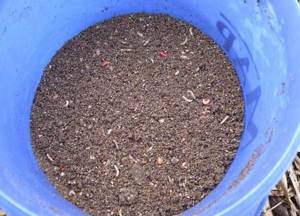
Homemade winter bait
The advantages of bait for crucian carp for winter fishing with your own hands are in careful manufacturing and selection of components. The mixture is assembled from the exact ingredients that work. And the price of such feeding is significantly lower. There are a huge variety of recipes. Let's look at the basic ones here, and then it's up to the fisherman. Only experimentally can one determine what works best for crucian carp in a particular body of water. Types of feeding for crucian carp in winter:
- A mixture with large particles (wet porridge or dry mixture poured directly into the hole) is a good bite at the beginning or end of winter.
- A finely dispersed mixture (dust), without a strong aroma and large feed particles - used in wilderness areas. Can be used dry or liquid - fill with water in a plastic bottle.
- Protein mixture (with the addition of yogurt or milk). It is also good to use in places where there is no small fish, otherwise the fry from all the surrounding areas will gather under the hole.
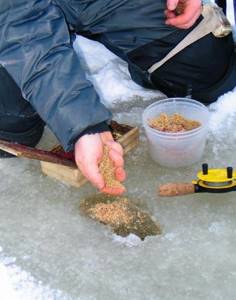
More often in winter, porridges based on millet , chaff, and corn grits are used separately or together, as in salapinka. The cereal is boiled, then broken up with breadcrumbs and flavored with flavoring (vanilla, toasted ground sunflower seeds). It turns out to be quite a sticky mass. Sometimes crucian carp simply eat such porridge, not paying attention to the bait of fishing rods, since it lies on the bottom in clumps, and it is convenient for the fish to eat it.
To reduce this effect, it is better to undercook the cereal and rinse it with cold water in a mesh colander. After this, dry mixture is added and the mixture is brought to the desired consistency - the ball forms, but crumbles when pressed lightly. This bait quickly breaks down into particles without forming large lumps. Against the background of small particles evenly scattered on the bottom and floating in the water, which you can’t get enough of, the bait on the hook of the tackle itself asks to be put into the mouth of the crucian carp.
The basis
The basic recipe for winter bait for crucian carp with your own hands begins with the base of the mixture. The following cereals are suitable as a base:
- Millet;
- Corn;
- Pearl barley;
- Barley;
- Wheat.
Millet is most often used, but in some reservoirs, barley or pearl barley works better. As we have already said, the cereal needs to be boiled in a large amount of water, but not completely, so that the grains do not boil. After this, the porridge should be rinsed in cold water. Some fishermen add a little salt and sugar when cooking, the main thing is not to overdo it.
Salt speeds up the digestion of fish, and crucian carp senses sugar in the water from afar. On some reservoirs, especially in the spring, fishermen don’t bother at all, pouring raw millet into the hole. Crucian carp are attracted by the color and shape of the bait components, which are similar to fish eggs. The smell of boiled porridge sometimes itself attracts crucian carp quite well without the use of additional flavorings.
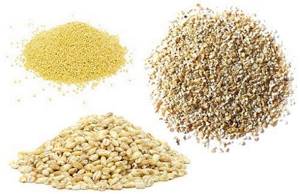
Breakdown
Next, the porridge needs to be brought to the required consistency - quite loose, but making it possible to form balls. To do this, breadcrumbs, semolina, oatmeal, and cake are added to the mixture. The most commonly used are crackers. In addition, crackers are suitable as dry bait on their own.
Animal components
If there are live bloodworms, maggots or worms, then they need to be added to the mixture. There is no bait better than pure bloodworms, but for regular fishing trips you need a large amount of it. Therefore, a plant mixture with the addition of live larvae is a cheaper alternative. If there is not enough quantity, a pinch of ordinary bloodworm for bait is crushed with your fingers and mixed into a mass. In winter, fish prefer to feed on food with higher energy value. The amount of protein in bait can also be increased by adding milk powder, egg powder, fish or meat and bone meal.
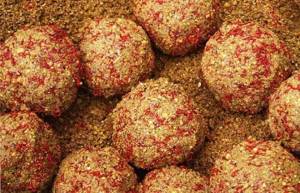
Flavors
Just like in the summer, when fishing for crucian carp in the winter, smell is not the least important factor. In winter, flavorings should be used extremely carefully, adding them a little at a time, not mixing a lot of different smells. It can be:
- Sunflower cake (roasted seeds, oil);
- Hemp (cake, seeds, oil);
- Vanilla;
- Cinnamon;
- Dill;
- Honey;
- Cocoa;
- Mint;
- Star ointment;
- Doctor Mom;
- Valerian;
- Anise;
- Garlic;
- Kerosene;
- WD-40;
- Moskitol.
There is no universal best supplement; in winter, everything needs to be tried separately and carefully. The simplest and almost always working option is vanilla and ground seeds.
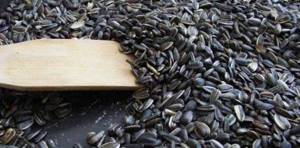
Store-bought bait
When it comes to fishing in unknown terrain, it is wise to stock up on commercial bait from a trusted brand. Baits produced industrially have many positive qualities:
- Ichthyologists and experienced fishermen share their opinions with formulation developers. Based on their experience and conclusions, the best composition combination can be applied. Thus, for the average crucian carp the composition is balanced and attractive.
- Store-bought baits have good water-permeable properties, but remain quite tenacious and do not fall apart. Such bait will be conveniently located in both horizontal and vertical planes.
- This will save you a lot of time. You won’t have to look for rare ingredients or spend a long time at the stove cooking.
Despite all the advantages of store-bought bait, the main choice of bait depends on the reservoir. Store-bought mixtures are often unable to take into account the individuality of a particular body of water.
This is generally acceptable for small lakes or small bodies of water located in an agricultural area. For years, in such places, fishermen have accustomed crucian carp to bait a species popular in this area. As a result, in one reservoir it would be better to use a corn base, while in another it would be millet.
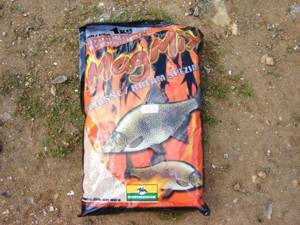
Dry mixture in a bottle
Is it necessary to wet the bait for crucian carp in winter in advance, at home? Usually the bait is prepared completely, even balls can be stuck in advance - doing this in the cold is not an option. It is important to keep wet bait from freezing. Sometimes, if it works, anglers simply pour the dry mixture into a plastic bottle and pour it directly into the hole.
This method only works in still water and shallow depths. In some ponds, crucian carp may be scared off by the smell of water other than its own. In this case, the use of dry bait is justified. You can pour water from the well into the bottle, shake and gradually pour the resulting suspension directly under the ice. In this case, the bottle must be kept warm so that the liquid in it does not freeze.
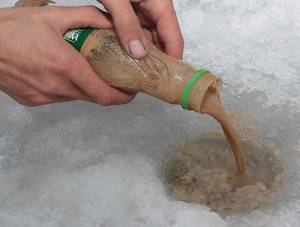
Adviсe

An experienced fisherman knows that success largely depends on subtleties and nuances. Here are some of them.
- Don't count on luck if the weather turns cold. A sharp rise in atmospheric pressure does not promote biting.
- For days with strong wind or frost, it is a good idea to have a winter tent. But in good weather I recommend doing without it. It's better to enjoy the fresh air and winter landscapes than to sit cooped up in the dark. Moreover, in a tent the holes have to be placed close to each other, and this is fraught with trouble. In open spaces, drill holes farther apart to avoid problems with adjacent gear getting tangled.
- The distance between the hooks on the float rod should not be too large and too small. I recommend no more than 25 cm. Short leashes are desirable, no more than 5 cm. It is important that the hooks do not touch when directed towards each other. The line for the leashes can be used a little thinner than the main one: if a break happens, it will only be the leash, and the rest of the equipment will remain intact. Long leashes are not needed: they often get tangled and twisted. You should not tie the top hook to the main line, as this increases the percentage of idle bites.
- You can lure crucian carp and whet its appetite not only by feeding it, but also by playing with the bait. If the bite is weak, do not be lazy to move the nod or float. I noticed this pattern as well. If the bite is sluggish on one tackle, it is worth playing with another - the intensity of the bite on the first one increases. Apparently, the crucian carp, greedy by nature, senses some movement, is afraid of losing food and rushes to swallow it. Or maybe he’s in a hurry to get to the next attractively moving portion.
- Crucian carp even under ice are sensitive to stomping, knocking and even loud voices, especially at shallow depths.
- If there is no bite or it subsides, you should take a closer look at your near and distant neighbors. Their “perseverance” and waving their arms should be a signal to you that there is something biting there. It's time to change your location and get closer to more successful fellow winter fishermen. Remember: an observant angler is a successful angler!
Formation of feeding tables in winter
If the location of the crucian carp is approximately known, and it is not visited by other fishermen, it can be fed for a long time. The fish learns that it is possible to feed in this place. Moreover, with constant supplementary feeding, sooner or later this point will be occupied by the largest individuals, who will simply drive away the small things from the hot spot. As a winter bait, it is better to use simply undercooked millet or pearl barley without additional additives. You need to dump several kilograms of this porridge into the hole in advance, 2-3 days before fishing, and then add it periodically.
Subscribe to the channel:
My YouTube channel RYBAFAN on fishing:
We're OK
Features of some types of porridge for catching crucian carp

Porridge is often used to attract crucian carp. You can take any proven recipe, the main thing is to achieve the desired consistency. Each porridge has its own characteristics:
- Millet porridge . It is considered universal, but consists of small grains. For this reason, it stays in the feeder for a short time during feeding.
- Pea porridge . Ideal for a spring. Very catchy.
- Mamalyga or corn porridge . The most catchy.
- Feed mill . It is well retained in the spring due to its viscosity.
Article on the topic: Crucian fish
How to properly feed crucian carp in a pond
To attract crucian carp, you don’t need to dump a whole bag of bait into the water. If the depth of the reservoir is shallow, it is enough to form a couple of balls with a diameter of 7-10 cm and throw them to the point. The bait must be added as the bite subsides. Sinking to the bottom, a small cloud forms, emitting a pleasant aroma and attracting fish.
If the depth of the reservoir is more than 4 meters, then it is advisable to use a self-expanding feeder. It will work approximately 1 meter from the bottom.
